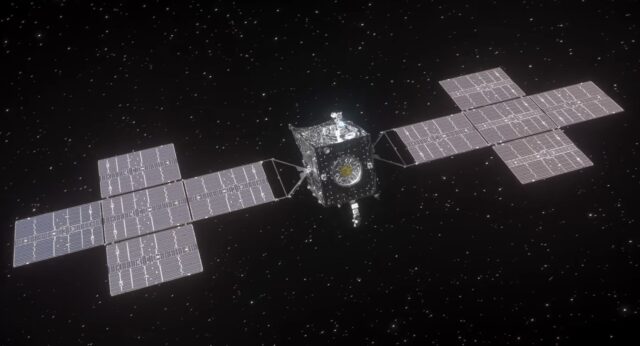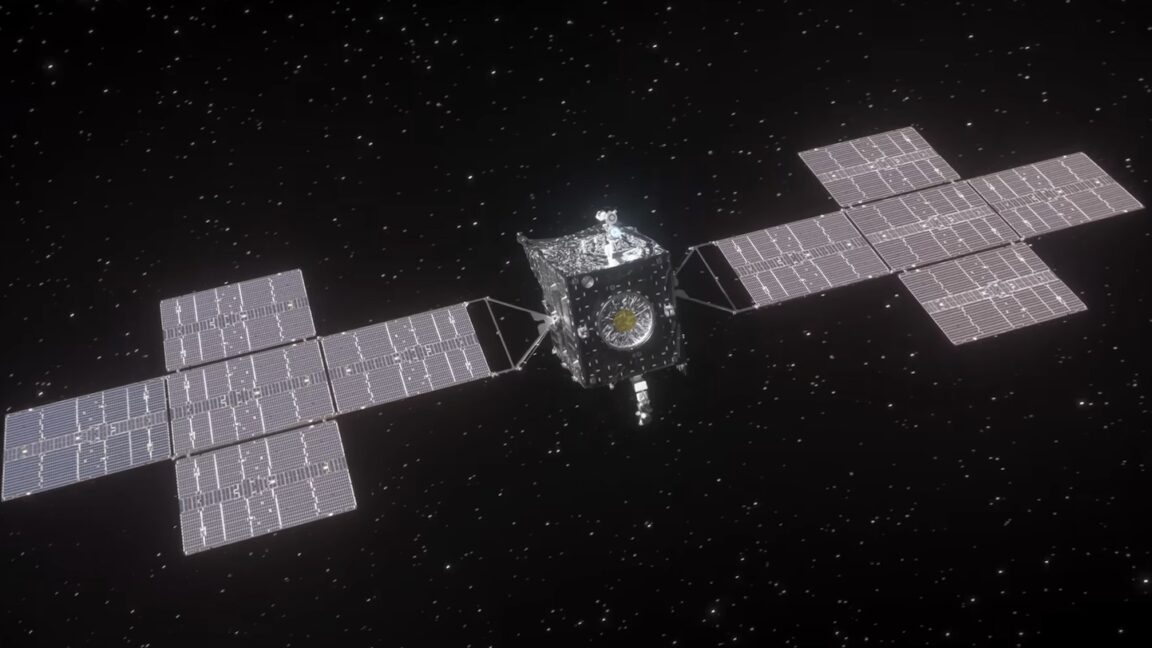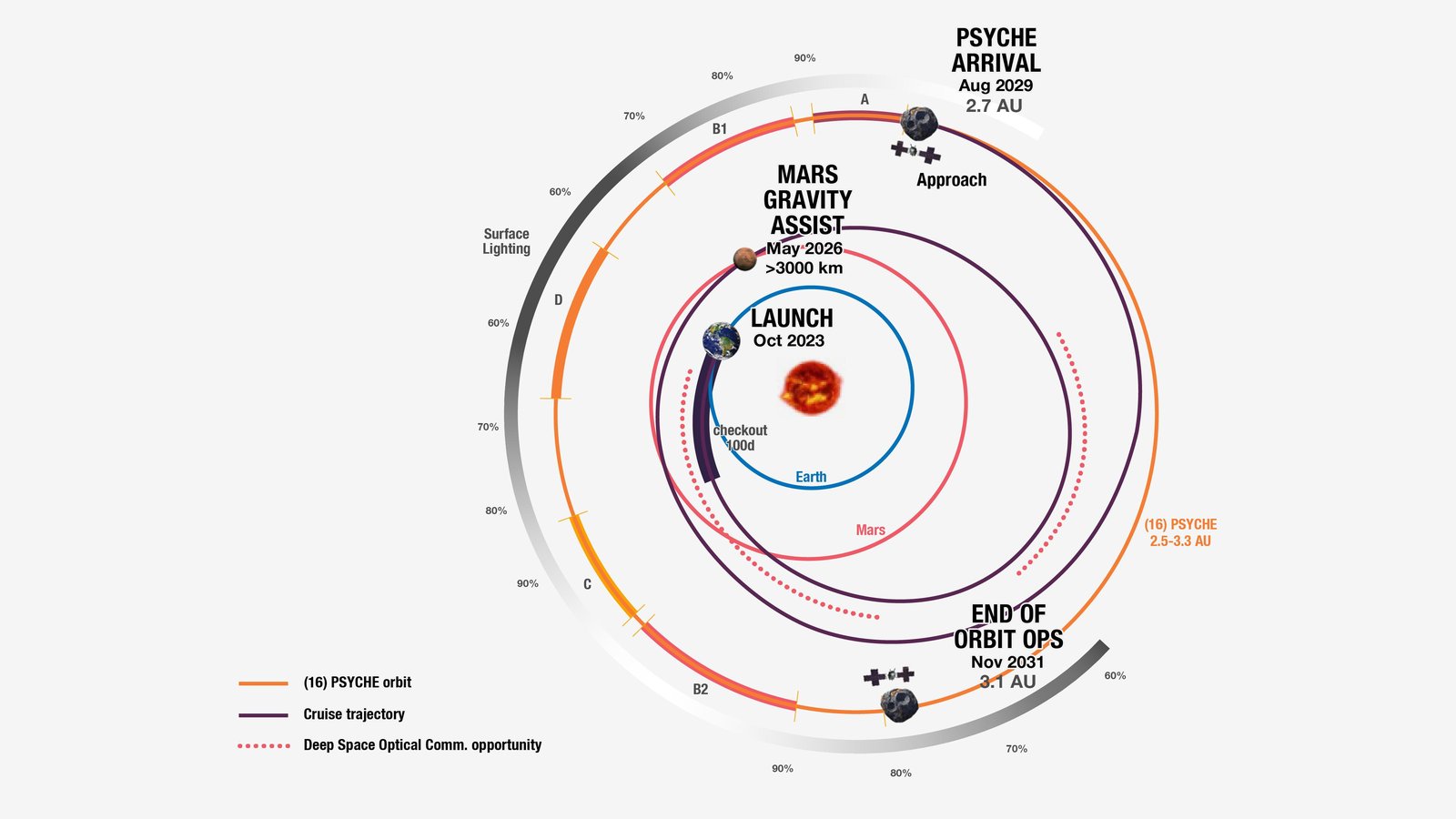- Регистрация
- 17 Февраль 2018
- Сообщения
- 38 866
- Лучшие ответы
- 0
- Reactions
- 0
- Баллы
- 2 093
Offline
Engineers switched to a backup fuel line less than a quarter of the way through Psyche's mission.


Artist's concept of NASA's Psyche spacecraft. One of its Hall thrusters is visible glowing blue in this illustration. Credit: NASA
A NASA spacecraft bound for an unexplored metal-rich asteroid has reignited its plasma thrusters, continuing its cruise deeper into the Solar System after switching to a backup fuel line.
The $1.4 billion Psyche mission, built to explore an asteroid with the same name, has four electric thrusters fueled by xenon gas. Psyche's solar electric propulsion system is more fuel efficient than conventional rocket thrusters, and it works by flowing xenon through an electromagnetic field, which ionizes the gas and expelling the ions at high speed to produce thrust.
The plasma engines generate lower thrust than chemical rocket engines, but they can accumulate years of run time over the course of a mission, enabling a spacecraft to make significant changes in its velocity to steer its way through space.
Psyche launched in October 2023 to kick off a six-year trip to its asteroid destination, located between the orbits of Mars and Jupiter. The robotic mission proceeded normally until April 1, when the spacecraft detected a drop in pressure inside the line that feeds xenon fuel to its four thrusters. The craft reacted to the pressure signature by powering off the thrusters.
Back in action
The good news is two-fold. First, one of the advantages of using electric thrusters is flexibility. With conventional thrusters, key burns on a deep space mission often must happen at the appointed time. In the case of this mission, the electric thrusters could remain powered off from April 1 until the middle of this month with no effect on the mission's scheduled arrival at asteroid Psyche in August 2029.
Secondly, the Psyche spacecraft's propulsion system has a backup fuel line. Ground controllers at NASA's Jet Propulsion Laboratory ended up commanding the probe to switch to the backup line last month, and test burns showed the thrusters worked well. The spacecraft resumed "full thruster operations" on Monday, according to NASA.
The spacecraft, built by Maxar Space Systems, will operate its electric thrusters for the equivalent of three months between now and November to keep the mission on track for arrival at asteroid Psyche in 2029.
"Through comprehensive testing and analysis, the team narrowed down the potential causes to a valve that may have malfunctioned in the primary line," NASA said in a statement Friday. "The switch to the identical backup propellant line in late May restored full functionality to the propulsion system."
The next waypoint on Psyche's voyage will be a flyby of Mars in May 2026. Officials expect Psyche to keep that date, which is critical for using Mars' gravity to slingshot the spacecraft deeper into the Solar System, eventually reaching the asteroid belt about four years from now.

NASA's Psyche spacecraft takes a spiral path to the asteroid Psyche, as depicted in this graphic that shows the path from above the plane of the planets, labeled with key milestones of the prime mission. Credit: NASA/JPL-Caltech
At Psyche, the spacecraft will enter orbit and progressively move closer to the asteroid, using a suite of sensors to map its surface, measure its shape, mass, and gravity field, and determine its elemental composition. Observations through telescopes suggest Psyche is roughly 140 miles (226 kilometers) in diameter, or about the width of Massachusetts. But it's likely not spherical in shape. Scientists describe its shape as more akin to a potato.
Potatoes come in lots of shapes, and researchers won't know exactly what Psyche looks like until NASA's asteroid explorer arrives in 2029. Psyche will be the first metallic, or M-type, asteroid visited by any spacecraft, and scientists are eager to study an object that's largely made of metals—probably iron, nickel, and perhaps some rarer elements— instead of rocky minerals.
With the Psyche spacecraft's plasma thrusters back in action, these goals of NASA's billion-dollar science mission remain achievable.
"The mission team's dedication and systematic approach to this investigation exemplifies the best of NASA engineering," said Bob Mase, Psyche project manager at JPL, in a statement. "Their thorough diagnosis and recovery, using the backup system, demonstrates the value of robust spacecraft design and exceptional teamwork."
But there's still a lingering concern whatever problem caused the valve to malfunction in the primary fuel line might also eventually affect the same kind of valve in the backup line.
"We are doing a lot of good proactive work around that possible issue," wrote Lindy Elkins-Tanton, Psyche's principal investigator at Arizona State University, in a post on X.
Listing image: NASA/JPL-Caltech/ASU


Artist's concept of NASA's Psyche spacecraft. One of its Hall thrusters is visible glowing blue in this illustration. Credit: NASA
A NASA spacecraft bound for an unexplored metal-rich asteroid has reignited its plasma thrusters, continuing its cruise deeper into the Solar System after switching to a backup fuel line.
The $1.4 billion Psyche mission, built to explore an asteroid with the same name, has four electric thrusters fueled by xenon gas. Psyche's solar electric propulsion system is more fuel efficient than conventional rocket thrusters, and it works by flowing xenon through an electromagnetic field, which ionizes the gas and expelling the ions at high speed to produce thrust.
The plasma engines generate lower thrust than chemical rocket engines, but they can accumulate years of run time over the course of a mission, enabling a spacecraft to make significant changes in its velocity to steer its way through space.
Psyche launched in October 2023 to kick off a six-year trip to its asteroid destination, located between the orbits of Mars and Jupiter. The robotic mission proceeded normally until April 1, when the spacecraft detected a drop in pressure inside the line that feeds xenon fuel to its four thrusters. The craft reacted to the pressure signature by powering off the thrusters.
Back in action
The good news is two-fold. First, one of the advantages of using electric thrusters is flexibility. With conventional thrusters, key burns on a deep space mission often must happen at the appointed time. In the case of this mission, the electric thrusters could remain powered off from April 1 until the middle of this month with no effect on the mission's scheduled arrival at asteroid Psyche in August 2029.
Secondly, the Psyche spacecraft's propulsion system has a backup fuel line. Ground controllers at NASA's Jet Propulsion Laboratory ended up commanding the probe to switch to the backup line last month, and test burns showed the thrusters worked well. The spacecraft resumed "full thruster operations" on Monday, according to NASA.
The spacecraft, built by Maxar Space Systems, will operate its electric thrusters for the equivalent of three months between now and November to keep the mission on track for arrival at asteroid Psyche in 2029.
"Through comprehensive testing and analysis, the team narrowed down the potential causes to a valve that may have malfunctioned in the primary line," NASA said in a statement Friday. "The switch to the identical backup propellant line in late May restored full functionality to the propulsion system."
The next waypoint on Psyche's voyage will be a flyby of Mars in May 2026. Officials expect Psyche to keep that date, which is critical for using Mars' gravity to slingshot the spacecraft deeper into the Solar System, eventually reaching the asteroid belt about four years from now.

NASA's Psyche spacecraft takes a spiral path to the asteroid Psyche, as depicted in this graphic that shows the path from above the plane of the planets, labeled with key milestones of the prime mission. Credit: NASA/JPL-Caltech
At Psyche, the spacecraft will enter orbit and progressively move closer to the asteroid, using a suite of sensors to map its surface, measure its shape, mass, and gravity field, and determine its elemental composition. Observations through telescopes suggest Psyche is roughly 140 miles (226 kilometers) in diameter, or about the width of Massachusetts. But it's likely not spherical in shape. Scientists describe its shape as more akin to a potato.
Potatoes come in lots of shapes, and researchers won't know exactly what Psyche looks like until NASA's asteroid explorer arrives in 2029. Psyche will be the first metallic, or M-type, asteroid visited by any spacecraft, and scientists are eager to study an object that's largely made of metals—probably iron, nickel, and perhaps some rarer elements— instead of rocky minerals.
With the Psyche spacecraft's plasma thrusters back in action, these goals of NASA's billion-dollar science mission remain achievable.
"The mission team's dedication and systematic approach to this investigation exemplifies the best of NASA engineering," said Bob Mase, Psyche project manager at JPL, in a statement. "Their thorough diagnosis and recovery, using the backup system, demonstrates the value of robust spacecraft design and exceptional teamwork."
But there's still a lingering concern whatever problem caused the valve to malfunction in the primary fuel line might also eventually affect the same kind of valve in the backup line.
"We are doing a lot of good proactive work around that possible issue," wrote Lindy Elkins-Tanton, Psyche's principal investigator at Arizona State University, in a post on X.
Listing image: NASA/JPL-Caltech/ASU
